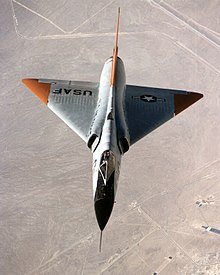Vortex lift
This article needs additional citations for verification. (October 2017) |



Vortex lift is a form of lift generated by delta wings operating at high angles of attack.
How it works
Vortex lift works by capturing vortices generated from the sharply swept leading edge of the wing. The vortex, formed roughly parallel to the leading edge of the wing, is trapped by the airflow and remains fixed to the upper surface of the wing. As the air flows around the leading edge, it flows over the trapped vortex and is pulled in and down to generate the lift.
Advantages and disadvantages
The major advantage of vortex lift is that it allows angles of attack that would stall a normal wing. Since it does not require camber to generate lift, but does require significant sweep back, vortex lift is utilized by most supersonic aircraft for landing; the characteristic bending nose of the commercial Concorde was built to allow the pilots to see over the nose during landing, when the aircraft was at a very high angle of attack.
The disadvantage of vortex lift is the drag that it produces. The large vortices generated when using vortex lift cause correspondingly high drag. This high drag can actually be considered advantageous during landing as it aids in slowing down the aircraft.
Among animals
Animals such as hummingbirds, and bats that eat pollen and nectar, are able to hover. They produce vortex lift with the sharp leading edges of their wings and change their wing shapes and curvatures to create stability in the lift.[1]
See also
References
- ^ "Leading Edge Vortex Allows Bats to Stay Aloft, Aerospace Professor Reports". USC Viterbi School of Engineering. 29 February 2008.
